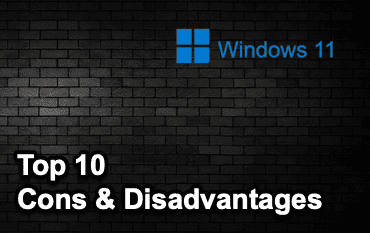
Windows 11, the latest operating system from Microsoft, represents a significant leap forward in design and features. However, with new updates come new challenges. Users have reported various issues, ranging from compatibility problems to performance glitches. This article aims to provide a comprehensive overview of the disadvantages associated with Windows 11, helping users and IT professionals make informed decisions about upgrading or maintaining their current systems.
While Windows 11 boasts many new features, its deployment has not been without setbacks. Criticisms include hardware compatibility requirements, changes in user interface, and potential privacy concerns. Understanding these limitations is crucial, especially for those considering transitioning from older versions of Windows. This article delves into the top ten disadvantages of using Windows 11, offering insights into the less-discussed aspects of this operating system.

If you are looking for a pm tool to manage your projects, consider AceProject. This tool is not based on the number of users, which can give you a lot of savings.
Top 10 Cons & Disadvantages of Windows 11

Before diving into the specifics, it’s essential to recognize that no operating system is perfect. Each has its own set of drawbacks, and Windows 11 is no exception. In the following sections, we will explore the top ten disadvantages since its release, ranging from system requirements to the impact on productivity and security concerns.
1. System Requirements
Windows 11, while a technological advancement, presents significant hardware compatibility challenges and demands that can be a deal-breaker for many users. This disadvantage primarily affects two key areas:
- Stringent Hardware Requirements: Windows 11 requires a Trusted Platform Module (TPM) 2.0 and supports only specific, recent processors. This strict requirement excludes many older computers and devices from upgrading to the new OS, alienating many potential users. The necessity for newer hardware can be a substantial financial burden, especially for organizations and individuals with a large inventory of older machines.
- Increased Resource Consumption: Windows 11 can be more resource-intensive than its predecessors, even for systems meeting the minimum hardware requirements. This increased demand for processing power and memory can lead to decreased performance in older systems that barely meet the upgrade criteria. Users might experience slower response times and reduced efficiency, especially when running multiple applications or more demanding software.
Real-Life Example: Consider a small business that utilizes a fleet of computers purchased in 2018. While functional and adequate for their current needs, these computers lack TPM 2.0. The company faces a dilemma – either continue using an outdated operating system without the benefits and security updates of Windows 11 or invest a significant amount of capital to upgrade its entire hardware infrastructure. This scenario is not uncommon and highlights the practical and financial implications of Windows 11’s hardware compatibility requirements.
2. User Interface Changes
Windows 11, in its pursuit of modernization, introduces a revamped user interface (UI) that has been met with mixed reactions. This shift presents notable challenges in terms of user adaptability and customization options:
- Steep Learning Curve: The overhaul of the Start Menu and taskbar, central to the Windows experience, now follows a centered design with simplified navigation. This change, while aesthetically pleasing to some, imposes a steep learning curve on users accustomed to the traditional layout. Adapting to this new setup can be time-consuming and potentially frustrating for long-time Windows users, disrupting their workflow and productivity.
- Reduced Customization Flexibility: One of the strengths of previous Windows versions was the ability to personalize various UI aspects. Windows 11, however, has scaled back on these customization options. This limitation impacts users who rely on specific settings and layouts for ease of use or accessibility reasons, forcing them to conform to a more rigid, one-size-fits-all interface.
Real-Life Example: A graphic designer who has been using Windows 10 for years upgrades to Windows 11. They find the centered taskbar and simplified Start Menu counterintuitive, disrupting their established workflow. Previously, they had a custom layout with quick access to frequently used applications and files tailored to optimize their productivity. The new system’s limited customization options make it challenging to recreate this efficient setup, leading to frustration and a temporary decline in work efficiency. This example underscores the real-world implications of Windows 11’s UI changes on individual productivity and comfort.
3. Software Compatibility Issues
The transition to Windows 11 has brought significant compatibility issues affecting software applications and hardware drivers. These challenges can have a direct impact on the functionality and efficiency of systems:
- Incompatibility with Legacy Software: Many businesses and individuals rely on older, specialized software that may not be immediately compatible with Windows 11. This incompatibility can disrupt essential workflows and necessitate unexpected upgrades or replacements, often at considerable expense and effort.
- Driver Issues for Peripheral Devices: Windows 11’s new architecture has led to driver compatibility problems, particularly with older hardware and peripheral devices. This can result in devices like printers, scanners, or external hard drives not functioning optimally or even becoming unusable, posing significant inconveniences and hindrances in personal and professional settings.
Real-Life Example: Consider a small accounting firm that uses a proprietary software suite developed specifically for their workflow. This software, tailored for Windows 10, encounters compatibility issues upon upgrading to Windows 11, leading to frequent crashes and data synchronization problems. Additionally, the firm’s older printer, integral to their daily operations, is no longer supported due to driver incompatibilities. The firm is thus faced with the costly decision to either downgrade back to Windows 10, update its specialized software, or replace its hardware – all of which involve significant time, effort, and resources. This situation highlights the practical challenges posed by software and driver compatibility issues in Windows 11.
4. Privacy Concerns
Windows 11 has sparked debates regarding user privacy and account requirements, emphasizing increasingly relevant concerns in our digital age. Two significant aspects stand out:
- Aggressive Data Collection: Windows 11 has extensive telemetry and data collection features. While these are intended to enhance user experience and system performance, they also raise privacy concerns. The level of data collection by default can be unsettling for users wary of their digital footprint and personal data security.
- Mandatory Microsoft Account for Home Users: Unlike previous versions, Windows 11 Home Edition mandates using a Microsoft account for initial setup and continued use. This requirement can be intrusive for users who prefer to operate anonymously or without tying their OS usage to an online account, limiting user autonomy and choice.
Real-Life Example: A freelance journalist, conscious of their digital privacy due to the sensitive nature of their work, upgrades to Windows 11. They are immediately confronted with the mandatory Microsoft account setup and the default settings that allow significant data collection. Concerned about the potential for data breaches and privacy intrusions, journalists spend considerable time navigating through settings to limit data sharing. This experience illustrates the tension between Windows 11’s features and the privacy concerns of users, especially those handling sensitive information in their professional lives.
5. Forced Updates
Windows 11’s approach to system updates has been a point of contention, blending convenience with potential disruption. This approach primarily impacts users in two significant ways:
- Compulsory Automatic Updates: Unlike its predecessors, Windows 11 often mandates automatic updates, which can be intrusive and disruptive. While intended to keep the system secure and up-to-date, these updates can initiate at inopportune times, interrupting work and other essential activities. Users have limited control over when these updates occur, leading to potential disruptions in productivity.
- Instability and Bugs Post-Update: New updates, though necessary, can sometimes introduce bugs and stability issues. This can be particularly problematic in a professional environment where reliability is paramount. These unexpected issues can affect software compatibility, system performance, and overall user experience, often requiring additional time and resources to troubleshoot and resolve.
Real-Life Example: An independent video editor working on a tight deadline experiences an automatic update during a critical editing session. This unscheduled interruption results in lost time and introduces a new bug that causes their editing software to crash intermittently. The editor must spend additional hours resolving these recent issues, directly impacting their workflow and deadline commitments. This scenario highlights the real-world implications of Windows 11’s forced update policy and its potential to disrupt professional environments.
6. Cost
The transition to Windows 11 carries a financial burden that can be particularly challenging for certain user groups. This financial impact manifests in two primary ways:
- Hardware Upgrade Costs: Windows 11’s stringent system requirements necessitate modern hardware, often requiring new purchases. Users with older machines that lack features like TPM 2.0 or do not meet the processor specifications face the tough choice of either remaining on an outdated system or incurring significant costs to upgrade their hardware.
- Software Licensing Expenses: For users who do not have a Windows 10 license eligible for a free upgrade, acquiring Windows 11 means purchasing a new license. This additional expense can be a hurdle, especially for small businesses or individuals on a tight budget.
Real-Life Example: A community college with a limited IT budget finds itself in a bind with the release of Windows 11. Their computer lab, comprising 30 PCs, has hardware that falls short of the new OS’s requirements. The college faces the daunting task of either upgrading all these machines, a move that would strain their budget, or preceding the benefits and security enhancements of the new system. This predicament illustrates the financial challenges and tough decisions that institutions and individuals may face with the advent of Windows 11.
7. Limited Gaming Performance
Windows 11 has impacted gamers, from performance issues to compatibility challenges. These gaming-related drawbacks are particularly noticeable in the following:
- Variable Gaming Performance: While Windows 11 promises enhanced gaming experiences with features like Auto HDR and DirectStorage, performance can vary. Some users report improved frame rates and visuals, but others experience decreased performance, especially on older hardware. This inconsistency can be frustrating for gamers who expect a seamless upgrade in gaming quality.
- Compatibility Issues with Older Games: The new OS has also introduced compatibility problems with older games. Gamers who enjoy classic or retro titles might find that these games do not run as smoothly on Windows 11, limiting their gaming library and enjoyment.
Real-Life Example: A gaming enthusiast, excited about the new features of Windows 11, upgrades their system, only to find that several of their favorite older games are no longer compatible. Additionally, they noticed a drop in performance in some newer titles, which previously ran flawlessly on their setup. This experience leads to a mix of disappointment and the hassle of finding workarounds or considering reverting to Windows 10 to keep their gaming collection accessible and enjoyable. This example underscores the potential pitfalls for gamers upgrading to Windows 11, particularly those who prefer older or less mainstream titles.
8. Integration with Microsoft Services
One of the more pronounced shifts in Windows 11 is its deep integration with Microsoft’s ecosystem, a move that has generated mixed responses. This integration affects users in two significant ways:
- Forced Use of Microsoft Services: Windows 11 is heavily tied to Microsoft’s OneDrive, Teams, and Edge services. While this provides a seamless experience for those already within the Microsoft ecosystem, it can be limiting for users who prefer alternative services. This lack of choice restricts user autonomy, compelling them to adapt to Microsoft’s suite of applications, irrespective of their personal preferences or needs.
- Reduced Flexibility for Third-Party Applications: The OS design and defaults favor Microsoft’s applications, making using third-party software as the default option less straightforward. This can be particularly inconvenient for users accustomed to and prefer other browsers, email clients, or cloud services.
Real-Life Example: A freelance writer who relies heavily on Google’s suite of applications, including Chrome and Google Drive, upgrades to Windows 11. They quickly find that the system defaults to Edge and OneDrive, complicating their workflow. The effort to constantly override these defaults to access their preferred applications becomes a recurring frustration, demonstrating how Windows 11’s integration with Microsoft services can hinder user experience and productivity, especially for those reliant on non-Microsoft products.
9. Accessibility Issues
Windows 11’s design changes affect accessibility and user-friendliness, particularly for individuals with specific needs or preferences. The key issues here include:
- Complex Interface for Certain Users: The new, more streamlined interface, while visually appealing, can pose challenges for users with accessibility needs. Navigating through the simplified Start Menu or the centered taskbar layout may be less intuitive for those who rely on established patterns and specific accessibility features.
- Limited Customization for Accessibility: While Windows 11 has introduced some accessibility improvements, they may not be sufficient for all users. The reduced ability to customize the interface to meet individual accessibility needs can be a significant drawback, especially for users who depend on a highly tailored computing environment.
Real-Life Example: A visually impaired teacher who used specific accessibility settings in Windows 10 to facilitate ease of use finds the transition to Windows 11 challenging. The new layout and reduced customization options for font sizes and contrast settings make it more difficult for them to navigate and use their computer efficiently. This change impacts their productivity and overall experience, highlighting the importance of considering diverse accessibility needs in operating system design.
10. Impact on Productivity
The introduction of Windows 11 has also brought about issues related to productivity and the consistency of user experience, particularly for those who switch between different versions of Windows. The main concerns are:
- Adjustment Period Reducing Productivity: Users upgrading to Windows 11 often face a period of adjustment due to its new features and layout. This learning curve can temporarily reduce productivity, especially for those who have been long-time users of previous Windows versions and are accustomed to a particular way of working.
- Inconsistency Across Different Environments: For users who operate in environments where multiple versions of Windows are in use (such as Windows 10 at work and Windows 11 at home), the inconsistency in user experience can lead to confusion and reduced efficiency. Adapting to different interfaces and functionalities can be time-consuming and hinder productivity.
Real-Life Example: An IT professional working in a mixed Windows 10 and 11 environment faces daily challenges. While they use Windows 11 at home, their workplace is still on Windows 10. This leads to a constant need to adjust to different interfaces and features, affecting their speed and efficiency in completing tasks. This situation exemplifies the productivity issues that can arise from the lack of consistency in user experience across different versions of the Windows operating system.
The 5 Worst Things About Windows 11
Windows 11, while a significant step forward in Microsoft’s operating system evolution, isn’t without its shortcomings. We’ll uncover the five challenges and frustrations with this new OS, from compatibility issues to user interface grievances.
- Stringent Hardware Requirements: Windows 11 demands more advanced hardware, leaving many users with older PCs unable to upgrade.
- Compatibility Issues with Older Apps: Some legacy applications struggle to run smoothly on Windows 11, causing inconvenience to users reliant on these programs.
- Complex User Interface: The redesigned Start menu and taskbar, while sleek, can be less intuitive for long-time Windows users, leading to a steeper learning curve.
- Removed Features: Certain beloved functionalities of Windows 10, such as Live Tiles and Cortana integration, have been withdrawn or significantly altered in Windows 11.
- Potential Privacy Concerns: With more integrated online features and data synchronization, some users express unease over privacy and data security in Windows 11.
Windows 10 vs. Windows 11: Should I Upgrade to Windows 11?

The decision to upgrade from Windows 10 to Windows 11 is pivotal and fraught with opportunities and challenges. This section, “Windows 11 vs. Windows 10: Should I Upgrade?” aims to dissect the intricacies of this decision, offering a clear, argumentative perspective on the matter. We will scrutinize the enhancements Windows 11 brings to the table, juxtaposed against the tried-and-true stability of Windows 10. Our analysis goes beyond mere feature comparison, delving into the impact of this upgrade on everyday functionality and long-term usability. Armed with this knowledge, readers will be poised to make an informed decision, understanding the full spectrum of implications of transitioning to Windows 11.
Reasons to Update to Windows 11
- Enhanced User Interface: Windows 11 introduces a more streamlined and intuitive interface, offering a modernized user experience with improved navigation and aesthetics.
- Improved Performance and Efficiency: This new version boasts faster speeds and better efficiency, particularly in handling modern hardware and software demands.
- Advanced Security Features: With a heightened focus on security, Windows 11 provides more robust protection against malware and cyber threats, ensuring a safer computing environment.
- Optimized for Modern Hardware: Designed to utilize the capabilities of the latest hardware entirely, Windows 11 maximizes the performance of newer processors, graphics cards, and SSDs.
- Enhanced Multitasking with Snap Layouts and Groups: Introducing features like Snap Layouts and Groups offers a more organized and efficient multitasking experience, perfect for the modern power user.
Reasons Not to Update to Windows 11
- System Requirements and Compatibility Issues: Windows 11 has stringent system requirements that may render older hardware incompatible, posing a significant hurdle for some users.
- Potential Software Incompatibility: There’s a risk that some older software and applications might not work seamlessly with Windows 11, disrupting workflow and productivity.
- Learning Curve: The transition to a new interface and system functionalities can require a considerable adjustment period, which might be inconvenient or challenging for some users.
- Early Adoption Risks: As with any new software release, early adopters might face bugs and stability issues that have yet to be resolved through updates.
- Lack of Significant Overhaul for Average Users: For the average user, the improvements in Windows 11 might not be substantial enough to warrant the hassle and potential cost of upgrading from a stable Windows 10 system.
Is Windows 11 Better than Windows 10?
Determining whether Windows 11 is better than Windows 10 is not a straightforward comparison, as it hinges significantly on the user’s specific needs and preferences. Windows 11, the latest iteration in Microsoft’s OS lineage, brings many new features and design improvements to enhance the user experience. Its streamlined interface, with a centered Start menu and new Snap Layouts, offers a more modern and efficient workspace. Additionally, Windows 11 is tailored for improved performance, especially on devices with the latest hardware, and boasts enhanced security features for a safer computing environment. However, these advancements come with the caveat of higher system requirements, potentially alienating users with older hardware who may find their devices incompatible with the new OS.
On the other hand, Windows 10, a tried and tested operating system, has established itself as a reliable and stable choice for many users. Its compatibility with a vast array of hardware and software makes it a versatile option for personal and professional use. Windows 10 continues to receive support and updates from Microsoft, ensuring its relevance and functionality. For users who value consistency and have set workflows, the familiarity with Windows 10’s interface and features might outweigh the allure of Windows 11’s new offerings. Moreover, for those concerned about the potential bugs and teething problems that often accompany new software releases, sticking with Windows 10 could be the safer bet.
Ultimately, whether Windows 11 is better than Windows 10 depends on personal preference and specific use cases. Power users and tech enthusiasts keen on embracing the latest technology and equipped with compatible hardware may find Windows 11 a superior choice, with its cutting-edge features and optimized performance. Conversely, for users who prioritize stability and broad compatibility and are using older hardware, Windows 10 remains a competent and reliable operating system. Both operating systems have their merits, and the choice largely depends on what the user values most in their computing experience.
Is Windows 11 Good and Worth It?
Windows 11 is a testament to Microsoft’s commitment to evolving user experience and system efficiency. It’s a bold stride forward, showcasing a modern interface, enhanced performance, and robust security features. The operating system is tailored for the future, leveraging the potential of cutting-edge hardware to deliver a smooth, responsive experience. With features like improved multitasking, advanced gaming capabilities, and a more cohesive integration with Microsoft’s ecosystem, Windows 11 is not just good; it’s a forward-thinking leap.
However, its worthiness is contingent on user-specific needs and hardware compatibility. Windows 11 is undoubtedly a worthy investment for those with the requisite technology, offering an enriched, streamlined computing experience. However, the upgrade might not be as compelling for users with older hardware or those reliant on legacy software. In essence, Windows 11 is a robust platform, brimming with potential, but its value lies in its alignment with the user’s personal and professional demands.
What is Windows 11?
Windows 11, Microsoft’s latest iteration of its long-standing operating system, marks a significant step forward in terms of design and functionality. This new version is characterized by:
- Revolutionized User Interface: Windows 11 introduces a completely redesigned user interface featuring a centered Start Menu and taskbar, rounded corners, and a more fluid aesthetic. This modern design aims to provide a more intuitive and streamlined user experience, reflecting current trends in interface aesthetics.
- Enhanced Performance and Security Features: It improves performance and security, including faster load times, better virtual desktop support, and integrated Microsoft Teams. Windows 11 also emphasizes security with features like TPM 2.0 support, adding a layer of protection against modern cyber threats.
Windows 11 Studies
Studies and user feedback have shown mixed reactions to Windows 11. While some praise its modern interface and new features, others express frustration over compatibility issues and the learning curve associated with the new design. Security experts have also discussed the implications of Windows 11’s privacy settings and data collection practices. These studies are crucial in understanding the broader impact of the OS on different user demographics.
- Microsoft Windows 11 Review
- Windows 11 Analysis by Wikipedia.org
- Windows 11 Cheat Sheet by TechRepublic
Conclusion
In conclusion, while Windows 11 brings several advancements and a fresh look to the Windows operating system, it also has cons and disadvantages. Users must carefully weigh these factors, from hardware requirements to privacy concerns. Considering each user or organization’s needs and circumstances before leaping Windows 11 is essential. As with any significant update, it brings opportunities and challenges, and being well-informed is crucial in navigating this new digital landscape.
Suggested article: Top 10 Pros & Advantages of Windows 11
Daniel Raymond, a project manager with over 20 years of experience, is the former CEO of a successful software company called Websystems. With a strong background in managing complex projects, he applied his expertise to develop AceProject.com and Bridge24.com, innovative project management tools designed to streamline processes and improve productivity. Throughout his career, Daniel has consistently demonstrated a commitment to excellence and a passion for empowering teams to achieve their goals.